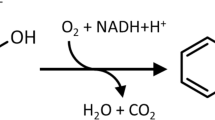Abstract
Recently isolated,Pseudomonas putida SN1 grows on styrene as its sole carbon and energy source through successive oxidation of styrene by styrene monooxygenase (SMO), styrene oxide isomerase (SOI), and phenylacetaldehyde dehydrogenase. For the production of (S)-styrene oxide, two knockout mutants of SN1 were constructed, one lacking SOI and another lacking both SMO and SOI. These mutants were developed into whole-cell biocatalysts by transformation with a multicopy plasmid vector containing SMO genes (styAB) of the SN1. Neither of these self-cloned recombinants could grow on styrene, but both converted styrene into an enantiopure (S)-styrene oxide (e.e.>99%). Whole-cell SMO activity was higher in the recombinant constructed from the SOI-deleted mutant (130 U/g cdw) than in the other one (35 U/g cdw). However, the SMO activity of the former was about the same as that of the SOI-deleted SN1 possessing a single copy of thestyAB gene that was used as host. This indicates that the copy number ofstyAB genes is not rate-limiting on SMO catalysis by whole-cell SN1.
Similar content being viewed by others
References
Furuhashi, K. (1992) Biological routes to optically active epoxides. pp. 167–186. In: A. N. Collins, G. N. Sheldrake, and J. Crosby (eds.). Chirality in Industry. Wiley, Chichester, UK.
Kim, H. S., J.-H. Lee, S. Park, and E. Y. Lee (2004) Biocatalytic preparation of chiral epichlorohydrins using recombinantPichia pastoris expressing epoxide hydrolase ofRhodotorula glutinis.Biotechnol. Bioprocess. Eng. 9: 62–64.
Choi, W. J. and C. Y. Choi (2005) Production of chiral epoxides: epoxide hydrolase-catalyzed enantioselective hydrolysis.Biotechnol. Bioprocess Eng. 10: 167–179.
Beltrametti, F., A. M. Marconi, G. Bestetti, C. Colombo, E. Galli, M. Ruzzi, and E. Zennaro (1997) Sequencing and functional analysis of styrene catabolism genes fromPseudomonas fluorescens ST.Appl. Environ. Microbiol. 63: 2232–2239.
O'Connor, K., C. M. Buckley, S. Hartmans and A. D. Dobson (1995) Possible regulatory role for nonaromatic carbon sources in styrene degradation byPseudomonas putida CA-3.Appl. Environ. Microbiol. 61: 544–548.
Hartmans, S., M. J. van der Werf, and J. A. de Bont (1990) Bacterial degradation of styrene involving a novel flavin adenine dinucleotide-dependent styrene monooxygenase.Appl. Environ. Microbiol. 56: 1347–1351.
Van Beilen, J. B., W. A. Duetz, A. Schmid, and B. Witholt (2003) Practical issue in the application of oxygenases.Trends Biotechnol. 21: 170–177.
Panke, S., M. Held, M. G. Wubbolts, B. Witholt, and A. Schmid (2002) Pilot-scale production of (S)-styrene oxide from styrene by recombinantEscherichia coli synthesizing styrene monooxygenase.Biotechnol. Bioeng. 80: 33–41.
Park, M. S., J. W. Bae, J. H. Han, E. Y. Lee, S.-G. Lee, and S. Park (2006) Characterization of styrene catabolic genes ofPseudomonas putida SN1 and construction of a recombinantEscherichia coli containing styrene monooxygenase gene for the production of (S)-styrene oxide.J. Microbiol. Biotechnol. 16: 1032–1040.
Chang, H.-L. and L. Alvarez-Cohen (1995) Transformation capacities of chlorinated organics by mixed cultures enriched on methane, propane, toluence, or phenol.Biotechnol. Bioeng. 45: 440–449.
Lee, E. Y., J. M. Kang, and S. Park (2003) Evaluation of transformation capacity for degradation of ethylene chlorides byMethylosinus trichosporium OB3b.Biotechnol. Bioprocess Eng. 8: 309–312.
Kang, J., E. Y. Lee, and S. Park (2001) Co-metabolic biodegradation of trichloroethylene byMethylosinus trichosporium is stimulated by low concentrations methane or methanol.Biotechnol. Lett. 23: 1877–1882.
Heipieper, H. J., F. J. Weber, J. Sikkema, H. Keweloh, and J. A. M. de Bont (1994) Mechanisms of resistance of whole cells to toxic organic solvents.Trends Biotechnol. 12: 409–415.
Choi, K. O., S. H. Song, and Y. J. Yoo (2004) Permeabilization ofOchrobactrum anthropi SY509 cells with organic solvents for whole cell biocatalyst.Biotechnol. Bioprocess Eng. 9: 147–150.
Panke, S., V. de Lorenzo, A. Kaiser, B. Witholt, and M. G. Wubbolts (1999) Engineering of a stable whole-cell biocatalyst capable of (S)-styrene oxide formation for continuous two-liquid-phase applications.Appl. Environ. Microbiol. 65: 5619–5623.
Panke, S., M. G. Wubbolts, A. Schmid, and B. Witholt (2000) Production of enantiopure styrene oxide by recombinantEscherichia coli synthesizing a two-component styrene monooxygenase.Biotechnol. Bioeng. 69: 91–100.
Kieboom, J., J. J. Dennis, J. A. M. de Bont, and G. J. Zylstra (1998) Identification and molecular characterization of an efflux pump involved inPseudomonas putida S12 solvent tolerance.J. Biol. Chem. 273: 85–91.
Schweizer, H. P. (1991)Escherichia-Pseudomonas shuttle vectors derived from pUC18/19.Gene 97: 109–121.
Park, M. S., J. H. Han, S. S. Yoo, E. Y. Lee, S. G. Lee, and S. Park (2005) Degradation of styrene by a new isolatePseudomonas putida SN1.Kor. J. Chem. Eng. 22: 418–424.
Han, J. H., M. S. Park, J. W. Bae, E. Y. Lee, Y. J. Yoon, S.-G. Lee, and S. Park (2006) Production of (S)-styrene oxide using styrene oxide isomerase negative mutant ofPseudomonas putida SN1.Enzyme Microb. Technol. 39: 1264–1269.
Sambrook, J., E. F. Fritsch, and T. Maniatis (1989)Molecular Cloning: A Laboratory Manual. 2nd ed., Cold Spring Harbor Laboratory Press, Cold Spring Harbor, NY, USA.
Padda, R. S., K. K. Pandey, S. Kaul, V. D. Nair, R. K. Jain, S. K. Basu, and T. Chakrabarti (2001) A novel gene encoding a 54 kDa polypeptide is essential for butane utilization byPseudomonas sp. IMT37.Microbiology 147: 2479–2491.
Speer, B. S., N. B. Shoemaker, and A. A. Salyers (1992) Bacterial resistance to tetracycline: mechanisms, transfer, and clinical significance.Clin. Microbiol. Rev. 5: 387–399.
Otto, K., K. Hofstetter, M. Rothlisberger, B. Whitholt, and A. Schmid (2004) Biochemical characterization of StyAB fromPseudomonas sp. strain VLB120 as a two-component flavin-diffusible monooxygenase.J. Bacteriol. 186: 5292–5302.
Mooney, A., N. D. O'Leary, and A. D. W. Dobson (2006) Cloning and functional characterization of thestyE gene, involved in styrene transport inPseudomonas putida CA-3.Appl. Environ. Microbiol. 72: 1302–1309.
Panke, S., B. Witholt, A. Schmid, and M. G. Wubbolts (1998) Towards a biocatalyst for (S)-styrene oxide production: characterization of the styrene degradation pathway ofPseudomonas sp. strain VLB120.Appl. Environ. Microbiol. 64: 2032–2043.
Author information
Authors and Affiliations
Corresponding author
Rights and permissions
About this article
Cite this article
Bae, J.W., Han, J.H., Park, M.S. et al. Development of recombinantPseudomonas putida containing homologous styrene monooxygenase genes for the production of (S)-styrene oxide. Biotechnol Bioproc E 11, 530–537 (2006). https://doi.org/10.1007/BF02932079
Received:
Accepted:
Issue Date:
DOI: https://doi.org/10.1007/BF02932079




